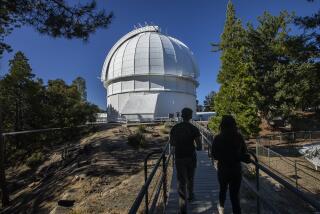Scientists Mourn ‘Major Loss’ of Radio Telescope That Collapsed
- Share via
For astronomer Martha P. Haynes of Cornell University, the strange collapse of a huge radio telescope in West Virginia this week was a devastating loss.
“Two years of work just went down the drain,” she said in a telephone interview.
The 300-foot dish was constructed 26 years ago as an “interim” facility and went on to become a world-class astronomical instrument, but it crashed to the ground Tuesday night, curtailing the work of hundreds of astronomers. No one knows yet what caused the accident, in which no one was hurt.
The National Radio Astronomy Observatory began lining up outside experts Thursday to investigate the incident.
“It’s a major loss to the whole scientific community,” said George A. Seielstad, director of the observatory at Green Bank, W. Va. The observatory is funded by the National Science Foundation.
The telescope was the largest radio telescope in the United States and it played a key role in numerous scientific discoveries. Many objects in the universe emit radiation at radio wavelengths, and astronomers can use radio waves to create images just as optical astronomers use visible light to take photographs.
The Green Bank facility filled a gap that no other telescope in the country can fill.
Astronomer Frank Drake of UC Santa Cruz, a pioneer in the relatively young field of radio astronomy, personally supervised the construction of the telescope.
“This was one of my babies,” said Drake, the first man to conduct a systematic search of the skies for evidence of extraterrestrial intelligence.
“The original plan called for a 600-foot telescope, but that was going to be more costly than we could afford,” Drake said. “We finally convinced the NSF (National Science Foundation) to provide $1 million with the understanding that we would build the largest telescope possible” to serve on an interim basis.
Designers held down the cost by limiting the functions of the telescope. It could not, for example, scan the entire sky, but it could raise and lower on the north-south meridian, so it could study any object in the northern sky even if it had to point at one spot and wait for the object to cross the meridian.
Funds for the replacement telescope never came, and over the years the facility was upgraded with highly sensitive detectors. It had recently been equipped with what Seielstad called “a very special receiver that could look at seven places in the sky simultaneously.”
That had enabled Seielstad to nearly complete a comprehensive series of sky surveys of sources of radio emissions. That project will have to be abandoned.
Some astronomers will undoubtedly be able to continue their work elsewhere, but for many the large telescope was absolutely vital.
Haynes, for example, was using the telescope for two projects.
For two years, Haynes and several colleagues have studied data collected by the Infrared Astronomical Satellite that seemed to show a supercluster of galaxies hidden from optical telescopes by the interstellar dust that obscures the region on the other side of the Earth’s Milky Way galaxy. The discovery of such a supercluster would rank as a major find in the field of astronomy.
But infrared sources on the other side of the Milky Way could be widely separated objects that appear close together because they lie in the same direction when viewed from Earth. To prove that the objects are a supercluster, it would be necessary to measure their distance from Earth precisely so that their relationship to each other could be determined.
The Green Bank telescope was to provide that measurement in the months ahead. Without it, Haynes said, the data from the satellite--and the two years it took to analyze it--is useless.
“It’s very sad,” she said.
Some astronomers speculated that the telescope collapsed because it has not been properly maintained by an organization that is pinched for funds. Although it was old, some said, it is difficult to understand why it should have collapsed on a mild, windless evening. One astronomer speculated that the support structures may have been allowed to corrode.
More to Read
Sign up for Essential California
The most important California stories and recommendations in your inbox every morning.
You may occasionally receive promotional content from the Los Angeles Times.










